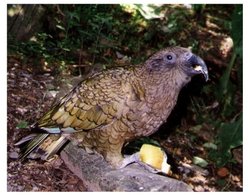Kea
|
|
- For other uses, see Kea (disambiguation).
| Kea Conservation status: Vulnerable | ||||||||||||||
|---|---|---|---|---|---|---|---|---|---|---|---|---|---|---|
 Alternative plumage | ||||||||||||||
| Scientific classification | ||||||||||||||
| ||||||||||||||
| Binomial name | ||||||||||||||
| Nestor notabilis Gould, 1856 |
Male_Kea_Milford_sound.jpg
The Kea (Nestor notabilis) is a semi-nocturnal parrot native to the alpine mountains of New Zealand. The Kea is the only known parrot in the world to live in the alpine regions. The Kea is also known as the clown of the mountains, because of its playful nature and reputation for tearing the rubber sealing from cars, presumably for fun. The Kea has also been known as the feathered wolf because of its reputation for attacking and killing farmers' livestock (predominantly sheep). The Kea is the only known species of parrot to attack and kill other animals, though this is generally rare and probably restricted to sick or trapped animals. They are probably the most active, intelligent, destructive and playful aviary birds, therefore making them very prone to behavioral problems and boredom if not well cared for.
Both female and male Kea are alike in their green coloration. Both have red plumage on the napes of their necks and underneath the wings that can be easily seen while in flight. The only true visible distinction between the genders is their mandible with the male having a larger longer curving upper mandible. The juvenile Keas have bright orange-yellow feathers around their mandible and nostrils, juveniles typically acquire their adult plumage at approximately eighteen months of age. Keas are predominantly ground avians, and are very playful in character, often amusing onlookers with their acrobatics and sideways hopping antics even to move forwards. They prefer the ground to arboreal habitats. Keas typically nest in crevices under rocks, in the roots of trees or hollow logs. Keas can typically be found in flocks of ten or more, and during breeding, juveniles can be found in groups topping the hundreds. Breeding seasons typically occur between July and January. Keas lay clutches of 2–4 eggs per season and these are incubated by the female for around twenty-nine days. When the chicks are a month old the male Kea assists in their feeding. Keas are reported to have polygamist breeding behaviors with the male pairing up with up to 4 females.
Their diet consists of leaves, buds, fruits, insects, carrion and the remains of dead animals. Keas need to obtain fats to survive the harsh alpine environment and have been known to visit local rookeries and rob the nests of their eggs or young chicks. They are reported to prize particularly the fat surrounding sheeps' kidneys, and stories are told of their riding sheep over cliffs to obtain these morsels.
The Kea is now a protected species, but was once hunted for a bounty paid by farmers for killing their sheep. At one time ten shillings were being offered per Kea beak, today that would be the equivalent of sixty-five dollars. Reports have documented an estimated 150,000 Keas to have been slaughtered during this period. In the 1970s the Kea received partial protection after census counted 5000 Keas. They were not fully protected until 1986, when farmers were persuaded to give up their legal right to shoot any Kea that tampered with property or livestock, in exchange the government agreed to investigate any reports of such problem birds and have them safely removed from the land. Despite sufferings incurred at the hands of humans the Kea remains a very friendly, playful human-loving bird.

